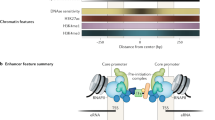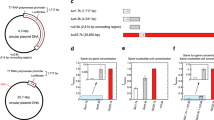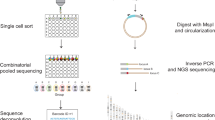Abstract
High mammalian gene expression was obtained for more than twenty different proteins in different cell types by just a few laboratory scale stable gene transfections for each protein. The stable expression vectors were constructed by inserting a naturally-occurring 1.006 kb or a synthetic 0.733 kb DNA fragment (including intron) of extremely GC-rich at the 5′ or/and 3′ flanking regions of these protein genes or their gene promoters. This experiment is the first experimental evidence showing that a non-coding extremely GC-rich DNA fragment is a super “chromatin opening element” and plays an important role in mammalian gene expression. This experiment has further indicated that chromatin-based regulation of mammalian gene expression is at least partially embedded in DNA primary structure, namely DNA GC-content.
Similar content being viewed by others
References
Cyranoski D. Giant bird-like dinosaur found: Chinese researchers unearth a surpising find. Nature. Published online 13 June 2007.
Fucheng Z H, Zhonhe Z H, Xing X, et al. A bizarre Jurrassic maniraptoran from China with elongate ribbon-like feathers. Nature, 2008, 455: 1105–1108, 10.1038/nature07447
Kost T A, Theodorakis N, Hughes S H. The nucleotide sequence of the chick cytoplasmic beta-actin gene. Nucleic Acids Res, 1983, 11: 8287–8301, 10.1093/nar/11.23.8287, 1:CAS:528:DyaL2cXpslGgtQ%3D%3D, 6324080
Bernardi G. Isochores and the evolutionary genomics of vertebrates. Gene, 2000, 241: 3–17, 10.1016/S0378-1119(99)00485-0, 1:CAS:528:DyaK1MXotVGksrw%3D, 10607893
Vinogradov A E. DNA helix: the importance of being GC-rich. Nucleic Acids Res, 2003, 31: 1838–1844, 10.1093/nar/gkg296, 1:CAS:528:DC%2BD3sXisFequrs%3D, 12654999
Cao H, Widlund H R, Simonsson T, et al. TGGA repeats impair nucleosome formation. J Mol Biol, 1998, 281: 253–260, 10.1006/jmbi.1998.1925, 1:CAS:528:DyaK1cXlsFSqsr8%3D, 9698546
Lowary P T & Widom J. New DNA sequence rules for high affinity binding to histone octamer and sequence-directed nucleosome positioning. J Mol Biol, 1998, 276: 19–42, 10.1006/jmbi.1997.1494, 1:CAS:528:DyaK1cXhs1yju7Y%3D, 9514715
Levitsky V G. RECON: A program for prediction of nucleosome formation potential. Nucleic Acids Res, 2004, 32: 346–349, 10.1093/nar/gkh482
Gardiner-Garden M, Frommer M. CpG islands in vertebrate genomes. J Mol Biol, 1987, 196: 261–282, 10.1016/0022-2836(87)90689-9, 1:CAS:528:DyaL2sXlt1ygsrc%3D, 3656447
Fregien N, Davidson N. Activating elements in the promoter region of the chicken beta-actin gene. Gene, 1986, 48: 1–11, 10.1016/0378-1119(86)90346-X, 1:CAS:528:DyaL2sXhtlaltrs%3D, 3470237
Anderson D C, Krummen L. Recombinant protein expression for therapeutic applications. Curr Opin Biotechnol. 13: 117–123
Jia Q, Li H C, Hui M, et al. A Bioreactor system based on a novel oxygen transfer method. Bioprocess Int, 2008, 6: 66–78, 1:CAS:528:DC%2BD1cXovFSgtLc%3D
Alexander M, Tarjei S M, Hongcang G, et al. Lander Genome-scale DNA methylation maps of pluripotent and differentiated cells. Nature, 2008, 454: 766–770
Saxonov S, Berg P, Brutlag D L. A genome-wide analysis of CpG dinucleotides in the human genome distinguishes two distinct classes of promoters. Proc Natl Acad Sci USA, 2006, 103: 1412–1417, 10.1073/pnas.0510310103, 1:CAS:528:DC%2BD28Xhs1Gnsrs%3D, 16432200
Takai D, Jones P A. Comprehensive analysis of CpG islands in human chromosomes 21 and 22. Proc Natl Acad Sci USA, 2002, 99: 3740–3745, 10.1073/pnas.052410099, 1:CAS:528:DC%2BD38Xis1KltrY%3D, 11891299
Author information
Authors and Affiliations
Corresponding authors
Rights and permissions
About this article
Cite this article
Jia, Q., Wu, H., Zhou, X. et al. A “GC-rich” method for mammalian gene expression: A dominant role of non-coding DNA GC content in regulation of mammalian gene expression. Sci. China Life Sci. 53, 94–100 (2010). https://doi.org/10.1007/s11427-010-0003-x
Received:
Accepted:
Published:
Issue Date:
DOI: https://doi.org/10.1007/s11427-010-0003-x




